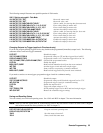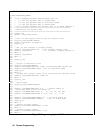
Remote Programming 53
SCPI Data Formats
All data programmed to or returned from the unit is ASCII. The data may be numerical or character string.
Numerical Data
Table 2-1. Numerical Data Formats
Symbol Data Form
Talking Formats
<NR1> Digits with an implied decimal point assumed at the right of the least-significant
digit. Examples: 273 0273
<NR2>
Digits with an explicit decimal point. Example: 273. .0273
<NR3>
Digits with an explicit decimal point and an exponent. Example: 2.73E+2 273.0E-2
Listening Formats
<NRf>
Extended format that includes <NR1>, <NR2> and <NR3>. Examples: 273 273.
2.73E2
<NRf+>
Expanded decimal format that includes <NRf>, MIN and MAX. Examples: 273
273. 2.73E2 MAX. MIN and MAX are the minimum and maximum limit values
that are implicit in the range specification for the parameter.
<Bool>
Boolean data. Either form 0 | 1 or OFF | ON may be sent with commands. Queries
always return a 0 or 1.
Suffixes and Multipliers
Some SCPI commands let you send engineering units as suffixes to extend numeric parameters. The following table lists the
allowable suffixes and multipliers.
Table 2-2. Suffixes and Multipliers
Class Suffix Unit Unit with Multiplier
Current A Ampere MA (milliampere)
Amplitude V Volt MV (millivolt)
Time S second MS (millisecond)
Common Multipliers
lE3 K kilo
1E-3 M milli
1E-6 U micro
Character Data
For query statements, character strings may be returned in either of the forms shown in table 2-3, depending on the length of
the returned string.
<CRD>
Character Response Data. Permits the return of character strings.
<AARD>
Arbitrary ASCII Response Data. Permits the return of undelimited 7-bit ASCII. This data type has
an implied message terminator.
<SRD>
String Response Data. Returns string parameters enclosed in double quotes.


















